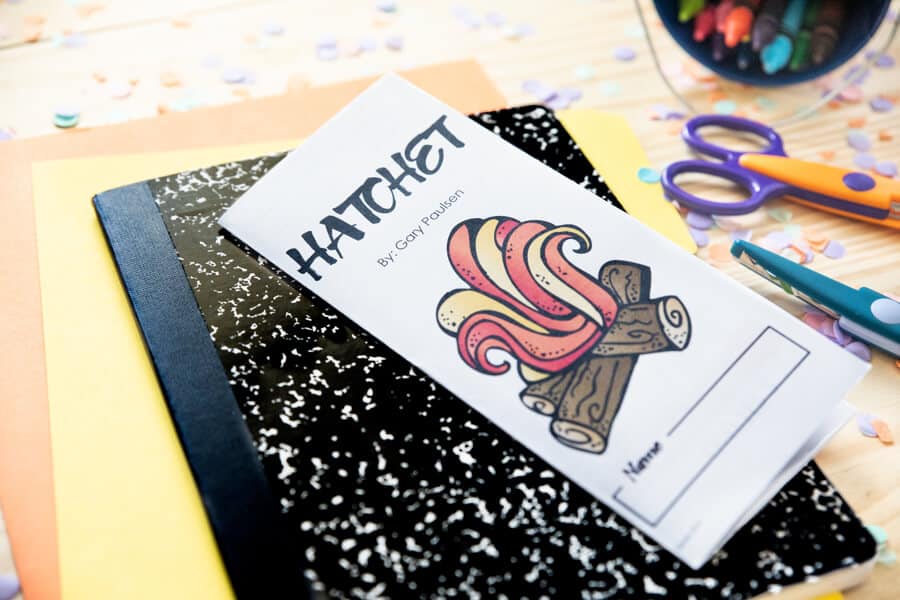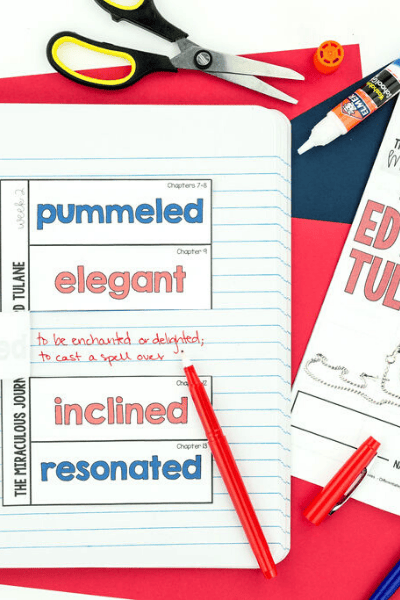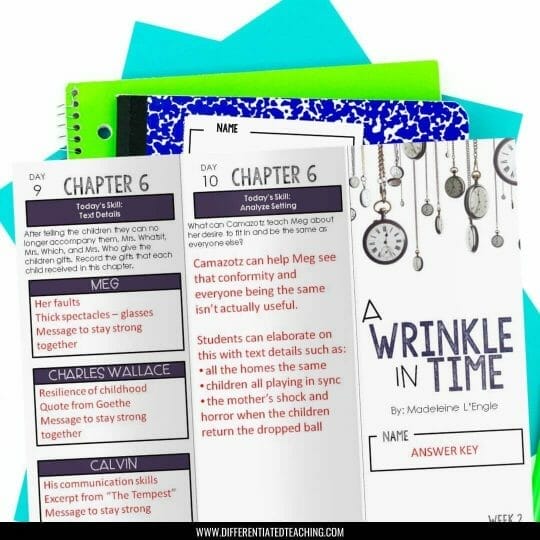Trifold Novel Studies 101: What is a trifold novel study?
Trifold novel studies are designed to engage students in higher-level thinking about literature without the long list of chapter questions that only focus on recalling the plot.
Students focus their daily reading response on core reading comprehension skills and vocabulary using popular chapter books appropriate for their reading level.

What is included in a trifold novel study?
Unlike many novel studies you might find online, trifold novel study activities aren’t full of pages and pages of chapter comprehension questions that focus on rote recall of the text. This is a purposeful decision. Instead, here’s what you’ll find a Differentiated Teaching novel study unit:
Teacher Novel Study Guides
This is the instructional guide for teachers. Novel study guides are included to support pacing. They also give guidance on each day’s instructional focus. The goal is to make these materials easy for you to plan for and differentiate based on the needs of your own classroom.
The guide is flexible enough that you can make adjustments or add to the lesson if you’d like to make connections to other course content but offers enough depth that you can develop a mini-lesson and spend an entire period focused on reading, targeting the day’s comprehension skill, and having student’s complete the provided task.
The core components of the trifold novel study guides are:
- Chapters or pages of the book to read
- Reading comprehension focus skill
- Tier 2 academic vocabulary related to the focus skill
- Text-based word of the day (selected from the day’s reading)
Here’s an example of what the novel study guide for the Wonder novel study looks like:
Vocabulary interactive notebook template
The vocabulary INB template is designed to be quick and easy for students to prepare. This is because the focus should be on learning the vocabulary not on cutting and gluing. While interactive notebook materials are engaging for learners, there is a fine line between keeping students engaged, and spending more time crafting than learning. The goal was to keep the engagement without the fluff.
These vocabulary flipbooks each cover one week of the novel study unit. They include each day’s text-based vocabulary word of the day. Here’s an example of what the final product looks like glued into a reader’s journal. This one is from The Miraculous Journey of Edward Tulane Novel Study.
When it comes to using these templates, they were designed for flexibility. That means there are a number of different possible uses. Here are a few of my favorites:
- Record the definition then draw a symbol to represent the word under the flap.
- Create a list of synonyms and antonyms
- Record the sentence from the text with the definition
- Write their own sentence using the word
- Write a definition based on context then record the dictionary definition.
Reading comprehension trifolds
The trifolds are the core of the comprehension component of the novel unit. They are purposefully designed to appear fun and approachable for students to help engage struggling and reluctant learners.
The trifolds fold easily to create a brochure format and each trifold covers one full week of reading responses. Students complete one section of the foldable each day.
The size makes them perfect for use as a bookmark. This is great because it also makes them more difficult for students to misplace than the traditional novel study packet. Here’s one from the Hatchet Novel Study to help you get an idea of their size compared to the average reading journal.

Inside the trifold novel study
The inside of the trifolds are meant to be easy for students to navigate independently. This makes it easy for them to stay on track with assignments.
As you can see in the Charlotte’s Web novel study trifold below, the top of each section is numbered to help students find daily work quickly. They’ll also find the day’s reading outlined for quick reference. This can be especially helpful for students who are doing independent novel work.

Each section of the trifold also includes the daily reading comprehension focus. This is clearly noted to help students make the connection between the task and the skill being targeted. The remaining portion of each day’s section focuses on providing the comprehension prompt and giving students space to respond.
Graphic organizers are included, where appropriate, to help guide student responses. These organizers are purposefully selected to be aligned with ones that are commonly seen on state testing. Here’s an example from The Boxcar Children Novel Unit.

Reading Comprehension Journal prompts
The cut & paste comprehension prompts are another way that you can differentiate these novel study activities for your students.
It is important to note that these questions align with those in the trifold so you can assign either option and know students are getting practice with the same skill.
Here are some reasons to consider the cut & paste prompts over the trifold format:
- Help keep all responses in a reading journal.
- Can be attached to a larger piece of construction paper for lit circle brainstorming
- Offers space for students to expand their responses and provide text-based evidence.
- Allows for the use of different paper – wider lines or color – where appropriate
Here’s what the cut and paste comprehension prompt novel study activities look like in a student reading journal. This is an example from the Holes Novel Study unit.

Answer keys and sample responses
Many of the questions in these novel study activities are designed to connect the text with the background knowledge of your students. They are provided with opportunities to share their thoughts and feelings and make connections with the text through embedded comprehension practice.
For example, a student might be asked to evaluate whether they’d want to be friends with a specific character as a way to examine character traits. The wording of the question, combined with the requirements for supporting their response would get to the comprehension skill without feeling overwhelming. You can see what this looks like in the example from the novel study for A Wrinkle in Time below.
That being said, many of the responses don’t have cut-and-dry answers.
This is why sample responses and text details that should be included are provided in the answer keys when a clear-cut answer isn’t possible. This is designed to help make grading easier. They also provide information on areas where the student should make connections between their personal experiences or opinions and the text.
Why trifold novel studies vs. traditional novel units?
The trifold novel study format allows for differentiation based on student needs and the compact foldable makes the written response less overwhelming for reluctant or struggling writers.
The content is based on prioritized skills that students need to master as they move up through reading levels, but the focus on a single skill each day allows students to dive deeper than traditional novel units that require students to respond to 3-10 questions per day.
The goal of trifold novel studies is not for the student to be well-versed in the book (although they do that, too). Instead, the trifolds help students develop a deep understanding of reading comprehension skills and strategies and how to apply them to text.
Want to know more?
Want to know more about how trifold novel studies can benefit your classroom? Here are five great things novel studies can do for your students.
Check out what I’m currently creating or browse all of the nearly 200 trifold novel studies currently available in my TPT shop and find the perfect novel for your classroom.









